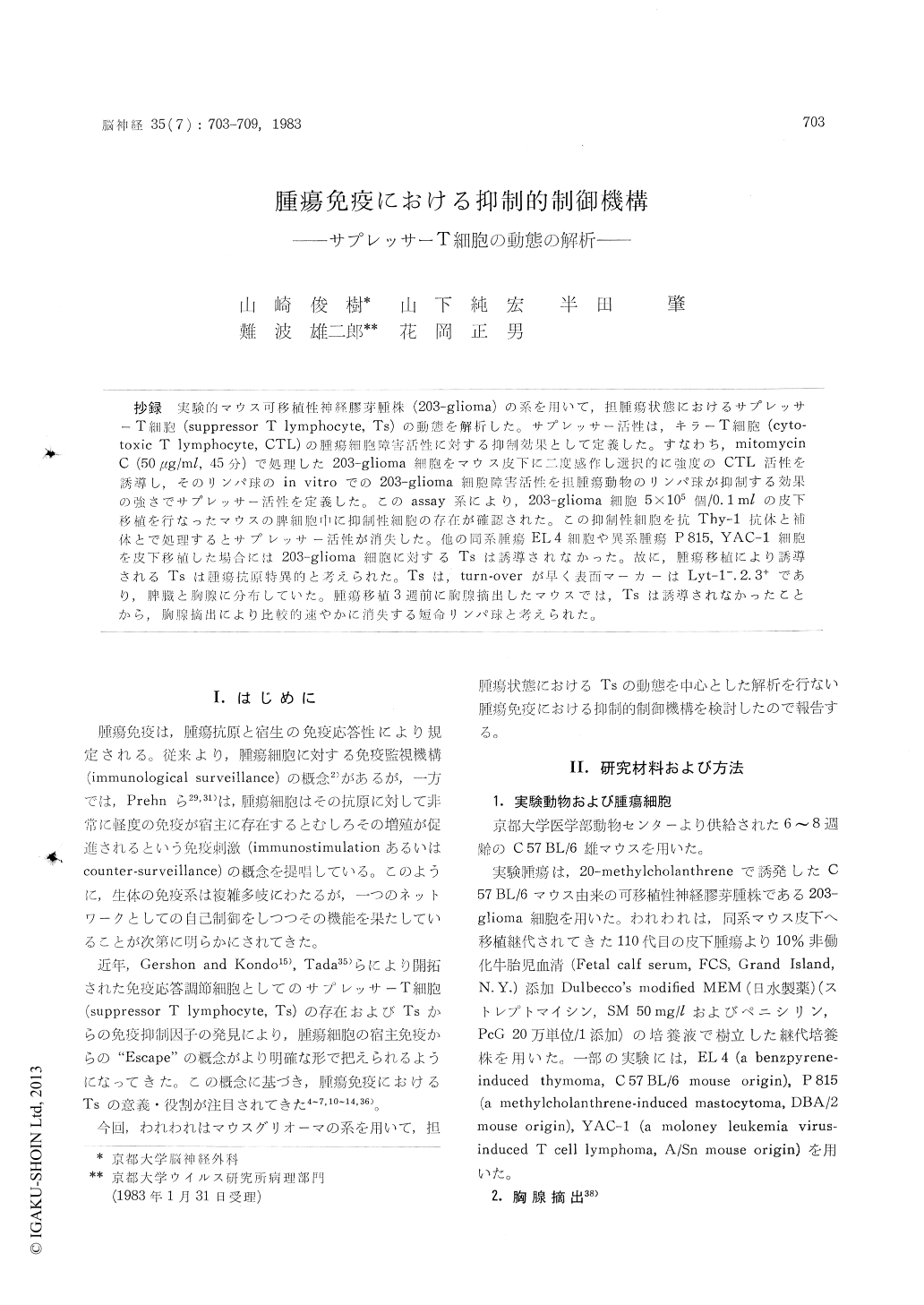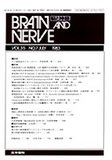Japanese
English
- 有料閲覧
- Abstract 文献概要
- 1ページ目 Look Inside
抄録 実験的マウス可移植性神経膠芽腫株(203—gliorna)の系を用いて,担腫瘍状態におけるサプレッサーT細胞(supPressor T lymphocyte, Ts)の動態を解析した。サプレッサー活性は,キラーT細胞(cyto—toxic T lymphocyte, CTL)の腫瘍細胞障害活性に対する抑制効果として定義した。すなわち, mitomycinC (50μg/ml,45分)で処理した203—glioma細胞をマウス皮下に二度感作し選択的に強度のCTL活性を誘導し,そのリンパ球のin vitroでの203—glioma細胞障害活性を担腫瘍動物のリンパ球が抑制する効果の強さでサプレッサー活性を定義した。このassay系により,203—glioma細胞5×105個/0.1mlの皮下移植を行なったマウスの脾細胞中に抑制性細胞の存在が確認された。この抑制性細胞を抗Thy−1抗体と補体とで処理するとサプレッサー活性が消失した。他の同系腫瘍EL 4細胞や異系腫瘍P815, YAC−1細胞を皮下移植した場合には203—glioma細胞に対するTsは誘導されなかった。故に,腫瘍移植により誘導されるTsは腫瘍抗原特異的と考えられた。Tsは,turn-overが早く表面マーカーはLyt−1—.2.3+であり,脾臓と胸腺に分布していた。腫瘍移植3週前に胸腺摘出したマウスでは,Tsは誘導されなかったことから,胸腺摘出により比較的速やかに消失する短命リンパ球と考えられた。
Suppressor T cells in syngeneic tumor-bearing mice that inhibited in vitro generation of tumor antigen-specific cytotoxic T lymphocytes werecharacterized with respect to the kinetics, the nature and the target specificity, using murine malignant glioma (a methylcholanthrene-induced malignant ependymoblastoma, 203-glioma).
Suppressor cell activity was assessed by the in-hibition of tumor cell killing activity of cytotoxic T lymphocytes, which were prepared from splenic T enriched lymphocytes of mice immunized with 1×106 mitomycin C (50 μg/ml, 45 minutes)-treated 203-glioma cells twice at an interval of 7 days.
It was confirmed that suppressor T cells were generated in 203-glioma-bearing mice, and they were tumor antigen-specific as evidenced by the fact that sensitized splenic T lymphocytes from mice bearing other syngeneic EL 4 thymoma or allogeneic P 815 mastocytoma or YAC-1 T cell lymphoma did not exhibit the inhibition of the cytotoxic T lymphocyte activity against 203-glio-ma cells.
Significant suppressor cell activity was detected in spleen cells 1 to 5 days after the subcutaneous inoculation of 203-glioma cells with the peak activity on day 3 and it disappeared as early as on day 7, suggesting strongly that the turn-over of suppressor T cells is very quick.
Surface markers of suppressor T cells in 203-glioma-bearing mice were checked on day 3 with the) results that the suppressor cell activity was eliminated by the treatment with anti-Lyt-2 monoclonal antibody and complement, indicating that the phenotype of suppressor T cells is Lyt-1-. 2.3+.
It was found that suppressor T cells in tumor-bearing mice were distributed in spleen and thymus, when the suppressor cell activity in various lymphoid organs such as spleen, thymus, regional or mesenteric lymph nodes, and bone marrow was assessed on day 3 after tumor cell inoculation.
The suppressor cell activity in mice thymecto-mized 3 weeks before tumor cell inoculation was assessed on day 3 after tumor cell inoculation with the results that it was abrogated in immune spleen cells from thymectomized mice. These may suggest that suppressor T cells in tumor-bearing mice are short-lived lymphocytes.
Accordingly, it may be postulated that in tumor-bearing hosts short-lived suppressor T cells or their precursors are induced predominantly with the target specifity and regulate the growth and differentiation of cytotoxic T lymphocytes and that adult thymectomy can affect the immunoregu-lation, possibly by altering the generation of short-lived suppressor T cells or their precursors.

Copyright © 1983, Igaku-Shoin Ltd. All rights reserved.


